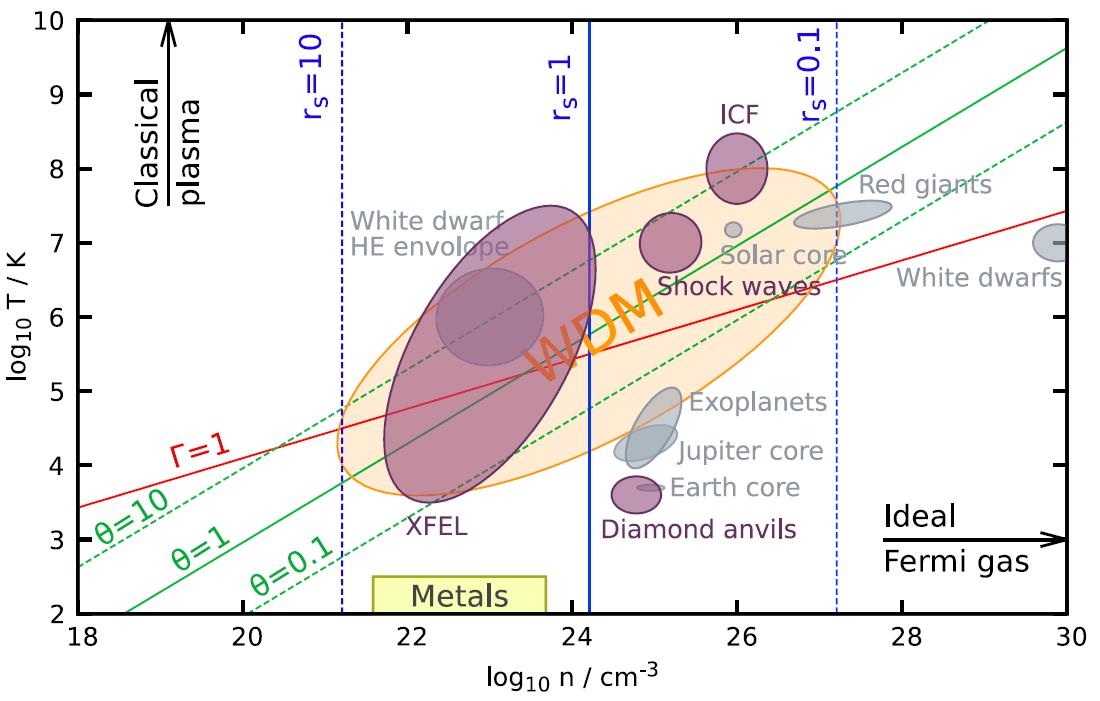Warm dense matter
The goal of the project is to develop novel theoretical schemes that accurately describe the thermodynamics, structure and dynamics of the uniform electron fluid within the warm dense matter regime and the dilute strongly coupled regime. The basis is the self-consistent dielectric formalism of the linear and nonlinear density response theory.
The uniform electron fluid [UEF] also known as jellium or quantum one-component plasma is universally acclaimed as one of the most important model systems in statistical mechanics, condensed matter physics and quantum chemistry. It constitutes the basis for the understanding of inhomogeneous electron systems in metals, semiconductors and even high energy density matter. Early interest in the UEF was naturally concentrated on its ground state at metallic densities leading to the development of key theoretical frameworks (quantum kinetic theory, self-consistent dielectric formalism, classical mapping approach) and the advancement of quantum Monte Carlo simulation methods (variational MC, diffusion MC). Zero temperature studies have led to remarkable insights such as the Bardeen-Cooper-Schrieffer microscopic theory of super-conductivity, Landau’s phenomenological theory of Fermi-liquids, the Bohm-Pines quasi-particle picture, the Wigner crystallization paradigm and the formulation of density functional theory [DFT] by Kohn and Sham. Concerning DFT, whose success in describing real materials remains unrivalled, the ground state exchange-correlation energy functional of the UEF is a key ingredient of the local spin density approximation and more sophisticated gradient approximations.
Interest has lately shifted to the warm dense matter regime [WDM] of the UEF, where finite temperature effects cannot be neglected whereas pure quantum effects and Coulomb interactions remain on an equal footing. WDM is an extreme state of matter that occupies a unique position in the density-temperature phase diagram of any chemical substance; between gases / plasmas and liquids / solids. Under WDM conditions, both condensed matter theory and ideal plasma theory break down, while Coulomb correlations, thermal excitations and fermionic exchange effects are entwined. Albeit extreme in terms of energy density, WDM conditions are not exotic but rather ubiquitous in nature and the laboratory. The WDM regime is relevant for dense astrophysical objects (giant planet interiors, brown and white dwarfs, neutron star crusts, Earth-like exoplanets with hot metallic core), fuel compression processes during inertial confinement fusion, compression with z-pinches or diamond anvil cells and any phenomenon that involves phase transition from the solid to the plasma state (intense laser-solid interactions, hypervelocity impacts).
From a theoretical perspective, the accurate description of the UEF under WDM conditions constitutes a truly formidable challenge given the lack of small parameters: (i) with respect to the strength of the Coulomb correlations which implies that established perturbative quantum kinetic theory approaches are not applicable, (ii) with respect to the level of quantum degeneracy which implies that effective semi-classical or ground state approaches are also not applicable. Very recently, there have been major breakthroughs at the computational front, where four complementary quantum MC methods have been devised (permutation blocking path integral MC, configuration path integral MC, density matrix MC and phaseless auxiliary-field MC) that avoid the notorious fermion sign problem at different WDM sub-regions. These tools have led to exact thermodynamic, structural and dynamic data in large regions of the WDM regime. In spite of the spectacular developments, no MC method is currently capable to cover the entire relevant parameter space and many fundamental questions remain unanswered.

The research project investigates the thermodynamic, static and dynamic properties of the uniform electron fluid. Focus lies on the warm dense matter and strongly coupled regimes that have recently been or will be soon accessible to state-of-the-art experiments, but also have astrophysical and technological significance. Novel theoretical non-perturbative schemes will be developed that utilize the full machinery of modern quantum and classical statistical mechanics and that involve uncontrolled approximations which are guided by dedicated cutting-edge path integral MC simulations. Long standing speculations of exotic electron collective behavior will be put to the test and even still-unconceived emergent phenomena are expected to manifest themselves. This line of research lies at the frontiers of contemporary plasma physics.
Former PhD student: Federico Lucco Castello
External Collaborators: Tobias Dornheim, CASUS, Görlitz, Germany & HZDR, Dresden, Germany - Zhandos Moldabekov, CASUS, Görlitz, Germany & HZDR, Dresden, Germany
